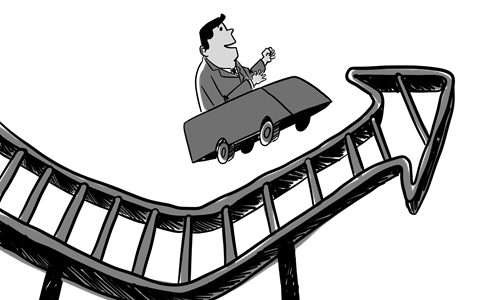HOME >> SOURCE
China’s economy has bottomed out
By Sheng Songcheng Source:Global Times Published: 2019/12/18 20:05:28

Illustration: Luo Xuan/GT
The Chinese economy has bottomed out. GDP growth this year is expected to grow by at least 6.1 percent. If we proceed with current economic operations and policies, the economic growth will not drop below 6 percent in 2020.Therefore, whether China should maintain 6 percent growth is not a valid question anymore. Deepening reforms, expanding opening-up, pushing up economic transformation and improving potential output are more important measures.
In the first three quarters of this year, capital accumulation contributed 19.8 percent of GDP growth, which is the lowest in two decades. As a more active fiscal policy is taking place and economic structure transformation continues, investment will hit bottom and then bounce back.
Infrastructure investment is expected to rise. Once the incremental capital is in place, there will likely be increasing infrastructure investment in the first quarter of next year. Besides the incremental capital, project selections and capital release mechanisms were changed. The situation can maintain a balance between countercyclical adjustment and fiscal sustainability, hence more effective infrastructure investment will stimulate economic potential.
The downward trend in real estate investment will turn around. Real estate financing can hardly be more stringent. The proportion of real estate financing of total financing has returned to the level of normal years.
Urbanization in China can still gain more ground compared to developed countries. Growing urbanization could churn out higher demand for newly built housing. China, with more nuclear families, has more household numbers as well.
The downward trend of real estate investment will impact future housing supplies. We need to maintain real estate investment at a reasonable growth in order to balance supply and demand, stabilizing fluctuating housing prices.
Several factors underpinned the stable consumption growth. Tax cuts have edged up the marginal propensity to consume, while tertiary industry has room to expand further with higher demand for services.
The economic and trade relation between China and the US is another influential factor. Judging from the progression of China-US trade talks, the decline in trade will soon bottom out.
Pricing and economic indicators have shown diminishing risks of a global recession. This could lead to improved external demand. So far, the manufacturing purchasing managers index (PMI) in the US, eurozone and Japan has picked up in the last two to three months. The US unemployment rate has hit a record 50-year low.
Economic operation has shown signs of marginal improvement. As a forward-looking index, China's PMI in November firmed up to 50.2, 0.9 percent higher month-on-month, moving back to positive territory while Caixin manufacturing PMI read 51.8 for the same period.
Producer price index, which was negative 1.6 percent in October, had some uptick in November.
China Transportation Services Index also increased. Those indexes have suggested China's economy is taking a turn for the better.
Other positive signals in the financial sector include continuous M1 growth, indicating more active business activities. Financing needs for the real economy were met. Plus, off the balance sheet financing has resumed.
China's foreign investment inflow maintains a stable growth as well. The country has attracted the most foreign capital among developing countries for 27 consecutive years. Despite the actual use of foreign capital declining worldwide in 2019, China stands as an attractive destination for foreign investors. It reflects that the world has faith in the future development of the Chinese economy.
China should deepen reforms to enhance its economic potential. The economy is at a stage of transforming from high-speed growth to high-quality growth.
The downward pressure the Chinese economy has faced recently resulted from structural problems and changes in its development model, aside from cyclical reasons. Persisting with economic structural adjustment, deepening reform and further opening-up is the way to go.
Monetary policy and fiscal policy will not change the potential for economic growth; rather they are measures of countercyclical adjustment. The progressing reform measure and technology advancement are expected to drive huge potential for the Chinese economy.
From the perspective of a business cycle, China's economy has bottomed out and holding a 6 percent growth rate next year is normal.
In terms of structural changes, China should stick to deepening reform and further opening-up to ramp up potential economic growth. The Chinese economy is poised to keep the momentum of stable growth in the long run. This fact will not change.
The author is a senior adviser to the People's Bank of China and adjunct professor of economics and finance at China Europe International Business School. bizopinion@globaltimes.com.cn
Posted in: EXPERT ASSESSMENT